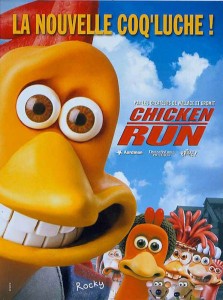 Last week, Sasha, now all of 15.5 months old, did something new: She signed. Now, she’d signed before—an occasional grasping hand for milk, fluttering both hands for “all done”—but this time she paired the sign, touching the tips of her fingers together on each hand, with a spoken word: “More.” And she did it again and again. It was pretty cool, much cooler, somehow, than her first actual spoken word, which was something like “Bye-bye.”
Last week, Sasha, now all of 15.5 months old, did something new: She signed. Now, she’d signed before—an occasional grasping hand for milk, fluttering both hands for “all done”—but this time she paired the sign, touching the tips of her fingers together on each hand, with a spoken word: “More.” And she did it again and again. It was pretty cool, much cooler, somehow, than her first actual spoken word, which was something like “Bye-bye.”
First off, this is, finally, indisputable proof that TV Is Good. Because about nine months ago, Sasha started watching the DVD of Baby Signing Time, a musical lesson in the basics of American Sign Language. It’s an entertaining 25 minutes, and she’s always gazed at it in rapt attention. Now, it seems to have taught her something (besides how to pick up the remote control, point it at the TV and say, “Baby!”).
But what’s really neat is that “more” isn’t just a word. Unlike, say, dog or milk, it’s an abstract concept, evidence that her mind is working on a human level. And it’s not her only spoken concept. She now regularly says “Bao-bao,” Mandarin for “Pick me up.” Yes, she can also say various nouns (among them the Chinese words for dog and milk), but that’s less impressive than her figuring out that if she’s finished chomping one grape, there exist somewhere “more” grapes. Her other abstract word is “Okay,” which signals assent and acceptance, concepts I’m still having trouble with. Soon, I imagine, Sasha will be counting. And then it’ll be time for a post-doc.
This whole process fascinates me because I’m almost always trying to improve my own language skills. I speak French, Italian, Spanish, Mandarin and Vietnamese, most of them extremely badly, though well enough to order a meal and direct a taxi. And I often have to pick up bits of new languages on the fly—in a week, for example, I’m going to have to stumble through German, Slovak, and Hungarian. There are phrase books to study, sure, but studying takes time, which I never have. If only I could pick up language the way Sasha does.
There is, of course, Rosetta Stone, the language-learning software that is big business nowadays. (It’s “used and trusted” by the State Department and the U.S. Army, they say.) Supposedly, the Rosetta Stone method involves learning a language the way a child would. Explains a video on Rosetta’s Website:
As a child, you learned language intuitively by experiencing the world around you. You saw something—let’s say a ball. Your parents told you that it’s a red ball. You repeated the words. Maybe they asked you to catch it, or throw it back to them. Without realizing it, you learned the object’s name, how to describe it, and what the actions are called.
This pitch sounds great, but after observing Sasha (who I have to take as an example of a normal child) I’m not so sure that’s how it works. I mean, surely she’s seen some kind of cause and effect related to the word “more,” but it’s absent all of those other associated nouns. She’s not saying “more grapes” or “more Baby Signing Time.” Just “more”—a concept divorced from its objects. It’s all very mysterious and fascinating to me, and I wish I could find a way to activate that process in my own brain.
Maybe reading this will help.
 In a charming essay here, a Londoner named Sathnam Sanghera cops to being a 33-year-old man whose biological clock is ticking. A Bridget Jones with testosterone, a Charlotte York before her Harry comes into the picture. It’s a nice personal essay, if a little too long, and Sanghera zeroes in on the thing that’s most striking about admitting to a longing for a baby: that it somehow seems unmasculine. It shouldn’t be, particularly because we so deeply romanticize the idea of, for example, fathers playing catch with sons. Besides, wanting a baby, at least in the circles I inhabit, is far more likely to get you hooked up than not. But it’s true that it does sound like something women want far more often than men, and that’s worth pointing out.
In a charming essay here, a Londoner named Sathnam Sanghera cops to being a 33-year-old man whose biological clock is ticking. A Bridget Jones with testosterone, a Charlotte York before her Harry comes into the picture. It’s a nice personal essay, if a little too long, and Sanghera zeroes in on the thing that’s most striking about admitting to a longing for a baby: that it somehow seems unmasculine. It shouldn’t be, particularly because we so deeply romanticize the idea of, for example, fathers playing catch with sons. Besides, wanting a baby, at least in the circles I inhabit, is far more likely to get you hooked up than not. But it’s true that it does sound like something women want far more often than men, and that’s worth pointing out.
